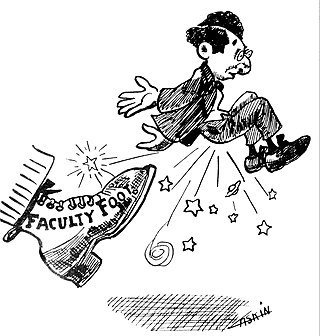A performance appraisal, also referred to as a performance review, performance evaluation, (career) development discussion, or employee appraisal, sometimes shortened to "PA", is a periodic and systematic process whereby the job performance of an employee is documented and evaluated. This is done after employees are trained about work and settle into their jobs. Performance appraisals are a part of career development and consist of regular reviews of employee performance within organizations.
Employment is a relationship between two parties regulating the provision of paid labour services. Usually based on a contract, one party, the employer, which might be a corporation, a not-for-profit organization, a co-operative, or any other entity, pays the other, the employee, in return for carrying out assigned work. Employees work in return for wages, which can be paid on the basis of an hourly rate, by piecework or an annual salary, depending on the type of work an employee does, the prevailing conditions of the sector and the bargaining power between the parties. Employees in some sectors may receive gratuities, bonus payments or stock options. In some types of employment, employees may receive benefits in addition to payment. Benefits may include health insurance, housing, and disability insurance. Employment is typically governed by employment laws, organisation or legal contracts.

Temporary work or temporary employment refers to an employment situation where the working arrangement is limited to a certain period of time based on the needs of the employing organization. Temporary employees are sometimes called "contractual", "seasonal", "interim", "casual staff", "outsourcing", "freelance"; or the words may be shortened to "temps". In some instances, temporary, highly skilled professionals refer to themselves as consultants. Increasingly, executive-level positions are also filled with interim executives or fractional executives.

Termination of employment or separation of employment is an employee's departure from a job and the end of an employee's duration with an employer. Termination may be voluntary on the employee's part (resignation), or it may be at the hands of the employer, often in the form of dismissal (firing) or a layoff. Dismissal or firing is usually thought to be the employee's fault, whereas a layoff is generally done for business reasons outside the employee's performance.

Dismissal is the termination of employment by an employer against the will of the employee. Though such a decision can be made by an employer for a variety of reasons, ranging from an economic downturn to performance-related problems on the part of the employee, being fired has a strong stigma in some cultures.

Recruitment is the overall process of identifying, sourcing, screening, shortlisting, and interviewing candidates for jobs within an organization. Recruitment also is the process involved in choosing people for unpaid roles. Managers, human resource generalists, and recruitment specialists may be tasked with carrying out recruitment, but in some cases, public-sector employment, commercial recruitment agencies, or specialist search consultancies such as Executive search in the case of more senior roles, are used to undertake parts of the process. Internet-based recruitment is now widespread, including the use of artificial intelligence (AI).
An employment contract or contract of employment is a kind of contract used in labour law to attribute rights and responsibilities between parties to a bargain. The contract is between an "employee" and an "employer". It has arisen out of the old master-servant law, used before the 20th century. Employment contracts relies on the concept of authority, in which the employee agrees to accept the authority of the employer and in exchange, the employer agrees to pay the employee a stated wage.
Permatemp is a U.S. term for a temporary employee who works for an extended period for a single staffing client. The word is a portmanteau of the words permanent and temporary.
In contract law, a non-compete clause, restrictive covenant, or covenant not to compete (CNC), is a clause under which one party agrees not to enter into or start a similar profession or trade in competition against another party. In the labor market, these agreements prevent workers from freely moving across employers, and weaken the bargaining leverage of workers.

The Worker Adjustment and Retraining Notification Act of 1988 is a U.S. labor law that protects employees, their families, and communities by requiring most employers with 100 or more employees to provide notification 60 calendar days in advance of planned closings and mass layoffs of employees. In 2001, there were about 2,000 mass layoffs and plant closures that were subject to WARN advance notice requirements and that affected about 660,000 employees.
On-the-job training is an important topic of human resource management. It helps develop the career of the individual and the prosperous growth of the organization. On-the-job training is a form of training provided at the workplace. During the training, employees are familiarized with the working environment they will become part of. Employees also get a hands-on experience using machinery, equipment, tools, materials, etc. Part of on-the-job training is to face the challenges that occur during the performance of the job. An experienced employee or a manager are executing the role of the mentor who through written, or verbal instructions and demonstrations are passing on his/her knowledge and company-specific skills to the new employee. Executing the training on at the job location, rather than the classroom, creates a stress-free environment for the employees. On-the-job training is the most popular method of training not only in the United States but in most of the developed countries, such as the United Kingdom, Canada, Australia, etc. Its effectiveness is based on the use of existing workplace tools, machines, documents and equipment, and the knowledge of specialists who are working in this field. On-the-job training is easy to arrange and manage and it simplifies the process of adapting to the new workplace. On-the-job training is highly used for practical tasks. It is inexpensive, and it doesn't require special equipment that is normally used for a specific job. Upon satisfaction of completion of the training, the employer is expected to retain participants as regular employees.
The Labor Code of the Philippines is the legal code governing employment practices and labor relations in the Philippines. It was enacted through Presidential Decree No. 442 on Labor day, May 1, 1974, by President Ferdinand Marcos in the exercise of his then extant legislative powers.
A workplace is a location where someone works, for their employer or themselves, a place of employment. Such a place can range from a home office to a large office building or factory. For industrialized societies, the workplace is one of the most important social spaces other than the home, constituting "a central concept for several entities: the worker and [their] family, the employing organization, the customers of the organization, and the society as a whole". The development of new communication technologies has led to the development of the virtual workplace and remote work.

The New Zealand Employment Relations Act 2000 is a statute of the Parliament of New Zealand. It was substantially amended by the Employment Relations Amendment Act 2001 and by the ERAA 2004.
Iranian labor law describes the rules of employment in Iran. As a still developing country, Iran is considerably behind by international standards. It has failed to ratify the two basic Conventions of the International Labour Organization on freedom of association and collective bargaining, and one on abolition of child labor. Countries such as the US and India have also failed to ratify many of these Conventions and a mere 14 other Conventions, only 2 since the Islamic Revolution.
Employee retention is the ability of an organization to retain its employees and ensure sustainability. Employee retention can be represented by a simple statistic. Employee retention is also the strategies employers use to try to retain the employees in their workforce.
South African labour law regulates the relationship between employers, employees and trade unions in the Republic of South Africa.
Shift-based hiring is a recruitment concept pioneered in Singapore that hires people for individual shifts, rather than hiring employees before scheduling them into shifts. Originally, it was intended as an efficient way to schedule shift-based part-time work, but it is now known that this concept can be applied to any job that requires a number of consecutive hours of commitment as a shift. This hiring concept focuses on employing workers for a particular shift on that particular day, rather than focusing on employing a worker to work recurrent shifts that can become part-time or full-time work, although the latter can be a result of employing a worker to work shifts that run at the same timing periodically. Every shift or a group of recurring shifts may be a unique job posting.
A human resources management system (HRMS) or Human Resources Information System (HRIS) or Human Capital Management (HCM) is a form of Human Resources (HR) software that combines a number of systems and processes to ensure the easy management of human resources, business processes and data. Human resources software is used by businesses to combine a number of necessary HR functions, such as storing employee data, managing payroll, recruitment, benefits administration, time and attendance, employee performance management, and tracking competency and training records.
Endo refers to a short-term employment practice in the Philippines. It is a form of contractualization which involves companies giving workers temporary employment that lasts them less than six months and then terminating their employment just short of being regularized in order to skirt on the fees which come with regularization. Some examples of such benefits contractual workers do not get as compared to regularized workers are the benefits of having an employer-and-employee SSS, Philhealth, and Pag-ibig housing fund contribution, unpaid leaves, and a 13th-month pay, among others.




